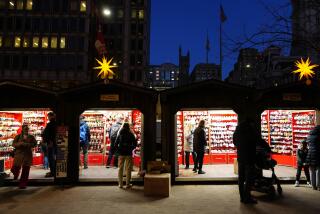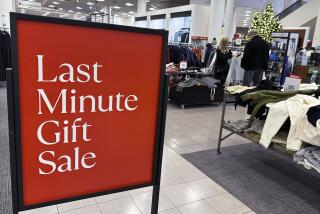December Sales Beat Expectations
Shoppers gave a Christmas bonus to retailers of both pricey and discount goods in December, lavishing dollars on such items as jewels from Tiffany and basics from Wal-Mart.
December sales growth was the best in seven years, with a year-over-year gain of 6.6% in stores open at least a year, according to the Bank of Tokyo-Mitsubishi. Goldman Sachs, tallying sales from a different collection of merchants, reported a 6.1% December retail gain over the previous year.
“The overall picture is still strong,” said Michael Niemira, of Tokyo-Mitsubishi. “The pattern of spending suggests that there’s momentum going forward.”
Higher-than-expected December sales before and after the holiday gave 1999 a retail ending almost as stellar as its sky-high beginning, in spite of a late-fall lull.
Tony sellers such as Neiman Marcus and value sellers such as Costco Wholesale Corp. fared best. Sellers in between, meanwhile, suffered from the classic middle-child syndrome of being overlooked.
“It tells us there are two kinds of people,” said Kurt Barnard, president of Barnard’s Retail Trend Report. “Those who are free to spend whatever they like without asking the price and those who might be able to buy a lot but don’t want to grow broke in the process.”
Wal-Mart Stores Inc. reported a 9.1% gain, well above an expected 6% to 7% gain. The number is significant because, as the biggest retailer in the world, Wal-Mart’s better-than-expected showing was enough to raise the entire retail composite, Niemira said.
Bloomingdale’s and Macy’s parent, Federated Department Stores Inc., also soared above the department store sector as a whole, posting a 6.4% same-store sales gain. Tiffany & Co. jewelers reported a 27% domestic gain, and Neiman Marcus Group Inc. reported sales up 14.4%, in part on the strength of luxury accessories, including shawls, scarves and jewelry.
Same-store sales are considered a good measure of retail performance because the figure excludes new and closed stores.
Holiday 1999 laggards included some of the companies that most needed a boost. Several mid-level stores posted flat or falling sales in stores open at least a year, including JCPenney, where weakness in men’s athletic clothes and juniors’ apparel meant holiday sales just a fraction of a percent ahead of last year.
Dayton Hudson Corp.’s struggling Mervyn’s California also fell harder than expected, as did Toys R Us Inc., which in 1998 lost its title of top toy seller to Wal-Mart. Analysts had expected a good season for the specialty toy chain, following a 13% sales gain in the third quarter.
In addition to a high-profile stumble in its online business, which failed to deliver some customers’ Christmas gifts on time, the company suffered from weak supply of important video products, one analyst said.
(BEGIN TEXT OF INFOBOX / INFOGRAPHIC)
Happy Holiday for Some
Consumers awarded some stores the retail equivalent of a shiny new bicycle for Christmas, while others barely got a lump of coalbased on growth in retail sales as compared with the same period the previous year. (Excludes new stores and stores that closed during 1999.)
*--*
Strong Showing Dec. 1999 Dec. 1998 Tiffany, domestic (Nov./Dec.) 27.0% 12.0% Costco 18.0 8.0 American Eagle Outfitters 16.9 20.9 Neiman Marcus 14.4 3.0 Talbots 11.8 5.0 Intimate Brands 10.0 6.0
*--*
*--*
Poor Showing Dec. 1999 Dec. 1998 Gymboree 36.0% 0.0% Restoration Hardware (9 weeks) 8.1 10.2% Toys R Us (Nov./Dec.) 2.0 7.0 Sears, Roebuck 0.6 0.3 JCPenney department stores 0.5 7.6 Mervyn’s California (Dayton Hudson Corp.) 0.4 5.2
*--*
Source: Goldman Sachs
More to Read
Inside the business of entertainment
The Wide Shot brings you news, analysis and insights on everything from streaming wars to production — and what it all means for the future.
You may occasionally receive promotional content from the Los Angeles Times.










